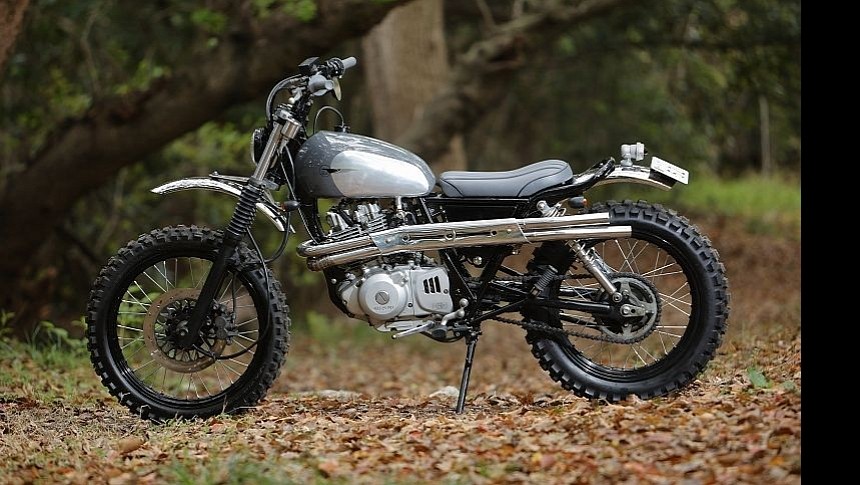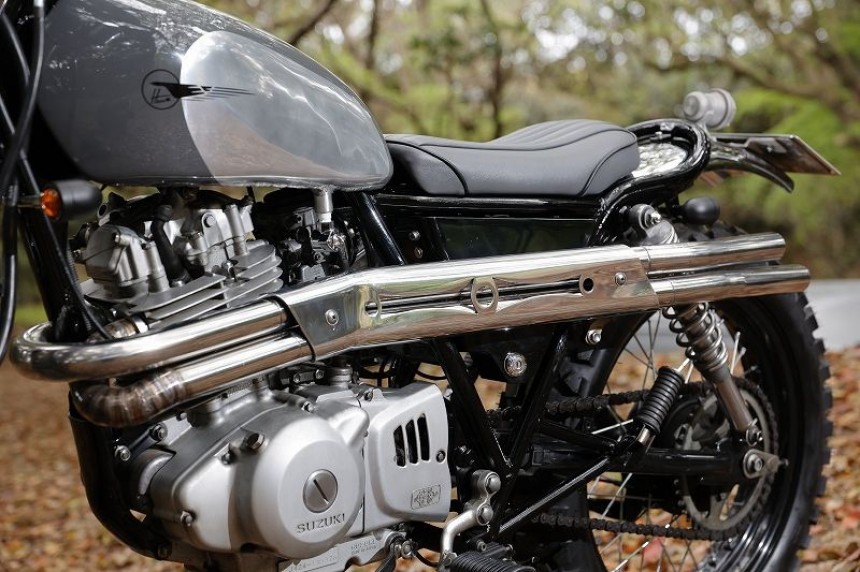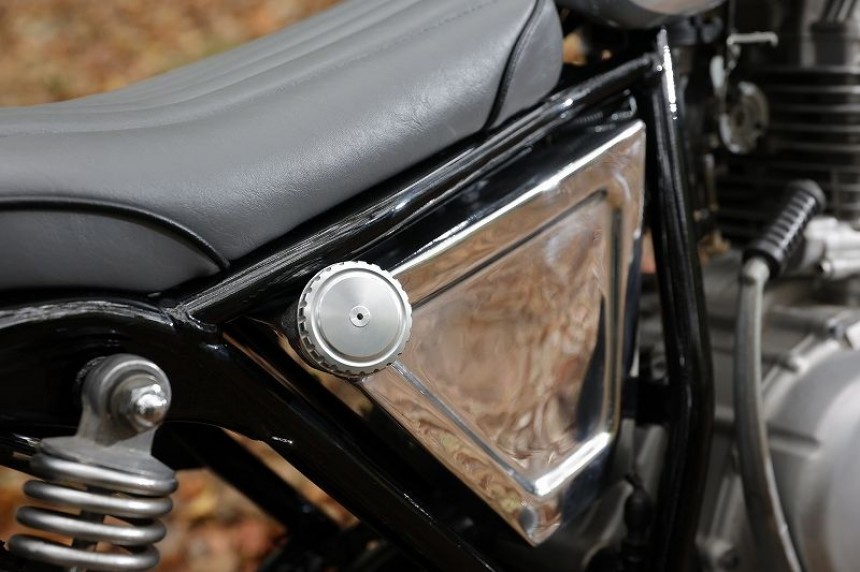It was a spring day back in 2005 when Kengo Kimura founded Heiwa Motorcycle in Hiroshima, so the workshop will soon be celebrating its 20th anniversary. Kimura-san currently operates at a different location in Hatsukaichi, and you’ll regularly see him appearing at the fabled Yokohama Hot Rod Custom Show.
He earned himself a couple of “Best in Show” awards thus far, but it’s probably just a matter of time before a third one comes along! In the past, we’ve looked at many of Heiwa’s custom showstoppers here on autoevolution, and there will always be room for more. There’s something distinctively Japanese about the motorcycles built by Kengo; something which we’ll never grow tired of admiring on our screens.
The man knows the importance of restraint and function over form, too, so his builds never look over the top or lack practicality. Now, the handsome scrambler we’re about to examine has all the tasty qualities that made us fall in love with Heiwa’s work in the first place. It’s purposeful, minimalistic, and packed full of cool little details from head to toe, but a relatively humble origin lies at its core.
Prior to receiving the custom treatment from master Kimura, this thing was a stock Suzuki TU250 belonging to the model-year 2000. The TU250 is also known as the Grasstracker Big Boy, which must be one of the most peculiar names ever given to a factory bike. With 20 hp on tap, its air-cooled 249cc single-cylinder mill could at best be described as modest, but the dry weight of just 273 pounds (124 kg) ensured a fun ride, nonetheless.
Once the teeny Suzuki was on his workbench, Kengo did away with its stock bodywork, exhaust system, and cockpit equipment. The standard lighting components are gone, too, yet all the running gear remains unchanged following Heiwa’s makeover. This is perfectly reasonable, because the motorcycle’s 20 ponies didn’t exactly call for premium suspension or brakes.
To get the ball rolling, Kimura-san began searching for a replacement fuel tank that would better suit the look he was after. He eventually found the perfect solution in the form of a handsome aluminum module, which had once belonged to a Suzuki RM250 from 1977. Its underside was extensively tweaked in order to fit on top of the TU250 frame like it was always meant to be there.
At the bike’s rear end, Heiwa shortened and looped the subframe before topping it off with a handmade solo seat. The saddle was put together from scratch using grey vinyl upholstery and just enough padding to keep the rider comfortable. In addition, Kengo installed high-mounted custom fenders on both ends, but he dressed them up in a shiny layer of chrome plating before doing so.
The rear fender supports a Bates-style LED taillight and a new license plate bracket, but the turn signals were attached to the subframe tubing a bit further ahead. An identical pair of blinkers can be found at the front, accompanying a tiny vintage-looking headlamp that sits far back in between the forks.
In the cockpit, this scrambled Grasstracker is the stuff of minimalists’ wet dreams, featuring a padded MX-style handlebar complete with Renthal grips and inconspicuous switches. A single underslung mirror can be seen on the right-hand side, while an aftermarket speedometer is mounted on the left. Now, let’s turn our attention back to the rear end for a minute.
What you see beneath the saddle isn’t an oil tank, but a secondary fuel chamber that can easily be detached when necessary. Heiwa kept hold of the TU250’s standard wheels, simply cloaking their rims in dual-purpose D603 rubber from Dunlop. The motorcycle was completely rewired, and its ignition has been relocated far back on the left flank to keep its cockpit extra-clean.
Just like the brakes and suspension, the 20-hp thumper remains pretty much unchanged. It does, however, make use of some fresh breathing equipment, inhaling via an aftermarket pod filter instead of the stock airbox. The exhaust is where things got really spicy, as Kengo fabricated a gorgeous set of pipes out of stainless-steel.
They sit nice and high on the left in true scrambler fashion, and temperatures are kept in check thanks to a bespoke heat shield. When it came time to tackle the paint job, Heiwa called in reinforcements. Regular collaborator Ninben was given a call and tasked with executing the muted, yet stunning paintwork, which saw the RM250 fuel tank finished in two shades of grey.
On the other hand, black was the color of choice for the frame, wheels, and fork lowers. Despite its monochromatic hues and an austere overall appearance, we doubt this TU250 scrambler will have any trouble drawing attention. The motorcycle displays a startling exercise in practical minimalism, and you can bet your bottom dollar that it’s incredibly fun to ride!
The man knows the importance of restraint and function over form, too, so his builds never look over the top or lack practicality. Now, the handsome scrambler we’re about to examine has all the tasty qualities that made us fall in love with Heiwa’s work in the first place. It’s purposeful, minimalistic, and packed full of cool little details from head to toe, but a relatively humble origin lies at its core.
Prior to receiving the custom treatment from master Kimura, this thing was a stock Suzuki TU250 belonging to the model-year 2000. The TU250 is also known as the Grasstracker Big Boy, which must be one of the most peculiar names ever given to a factory bike. With 20 hp on tap, its air-cooled 249cc single-cylinder mill could at best be described as modest, but the dry weight of just 273 pounds (124 kg) ensured a fun ride, nonetheless.
Once the teeny Suzuki was on his workbench, Kengo did away with its stock bodywork, exhaust system, and cockpit equipment. The standard lighting components are gone, too, yet all the running gear remains unchanged following Heiwa’s makeover. This is perfectly reasonable, because the motorcycle’s 20 ponies didn’t exactly call for premium suspension or brakes.
At the bike’s rear end, Heiwa shortened and looped the subframe before topping it off with a handmade solo seat. The saddle was put together from scratch using grey vinyl upholstery and just enough padding to keep the rider comfortable. In addition, Kengo installed high-mounted custom fenders on both ends, but he dressed them up in a shiny layer of chrome plating before doing so.
The rear fender supports a Bates-style LED taillight and a new license plate bracket, but the turn signals were attached to the subframe tubing a bit further ahead. An identical pair of blinkers can be found at the front, accompanying a tiny vintage-looking headlamp that sits far back in between the forks.
In the cockpit, this scrambled Grasstracker is the stuff of minimalists’ wet dreams, featuring a padded MX-style handlebar complete with Renthal grips and inconspicuous switches. A single underslung mirror can be seen on the right-hand side, while an aftermarket speedometer is mounted on the left. Now, let’s turn our attention back to the rear end for a minute.
Just like the brakes and suspension, the 20-hp thumper remains pretty much unchanged. It does, however, make use of some fresh breathing equipment, inhaling via an aftermarket pod filter instead of the stock airbox. The exhaust is where things got really spicy, as Kengo fabricated a gorgeous set of pipes out of stainless-steel.
They sit nice and high on the left in true scrambler fashion, and temperatures are kept in check thanks to a bespoke heat shield. When it came time to tackle the paint job, Heiwa called in reinforcements. Regular collaborator Ninben was given a call and tasked with executing the muted, yet stunning paintwork, which saw the RM250 fuel tank finished in two shades of grey.
On the other hand, black was the color of choice for the frame, wheels, and fork lowers. Despite its monochromatic hues and an austere overall appearance, we doubt this TU250 scrambler will have any trouble drawing attention. The motorcycle displays a startling exercise in practical minimalism, and you can bet your bottom dollar that it’s incredibly fun to ride!













